1994 PONTIAC GRAND-AM maintenance
[x] Cancel search: maintenancePage 188 of 274
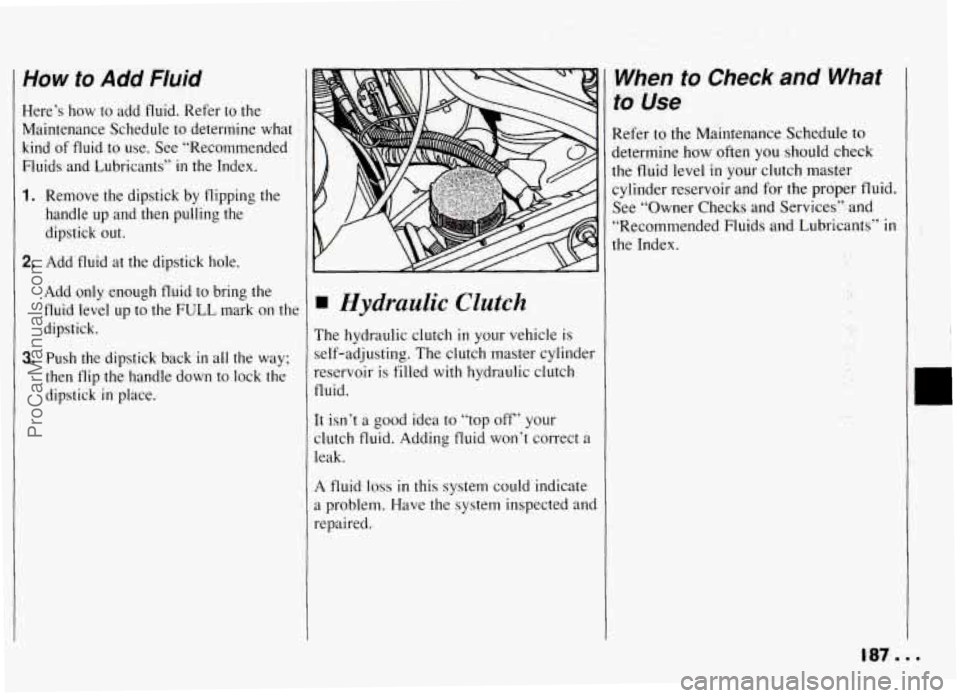
How to Add Fluid
Here’s how to add fluid. Refer to the
Maintenance Schedule to determine what
kind of fluid
to use. See “Recommended
Fluids and Lubricants”
in the Index.
1. Remove the dipstick by flipping the
handle up and then pulling the
dipstick out.
2. Add fluid at the dipstick hole.
Add only enough fluid to bring the
fluid level up to the
FULL mark on the
dipstick.
3. Push the dipstick back in all the way;
then flip the handle down to lock the
dipstick
in place.
Hydraulic Clutch
The hydraulic clutch in your vehicle is
self-adjusting. The clutch master cylinder
reservoir is filled with hydraulic clutch
fluid.
It isn’t a good idea to “top off’ your
clutch fluid. Adding fluid won’t correct a
leak.
A fluid loss in this system could indicate
a problem. Have the system inspected and
repaired.
When to Check and What
to Use
Refer to the Maintenance Schedule to
determine how often you should check
the fluid level
in your clutch master
cylinder reservoir and for the proper fluid.
See “Owner Checks and Services” and
“Recommended Fluids and Lubricants”
in
the Index.
187...
ProCarManuals.com
Page 191 of 274
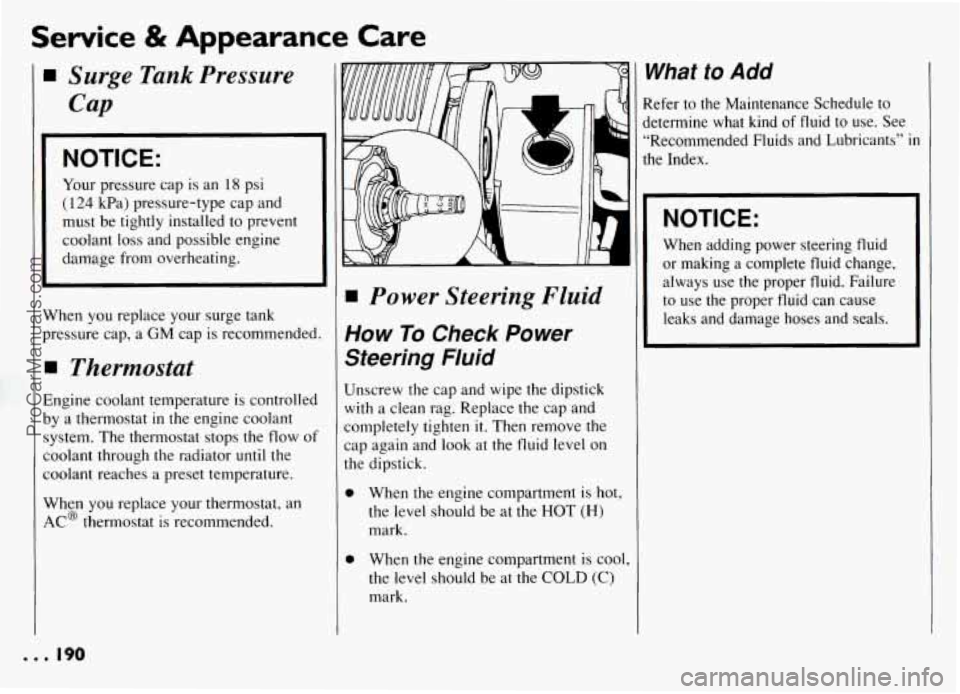
Service & Appearance Care
V
P
I
E
b
S’
C
C.
P
A
I Surge Tank Pressure
Cap
NOTICE:
Your pressure cap is an 18 psi
( 124 kPa) pressure-type cap and
must be tightly installed to prevent
coolant
loss and possible engine
damage from overheating.
irhen you replace your surge tank
ressure cap, a GM cap is recommended.
I Thermostat
lngine coolant temperature is controlled
y a thermostat in the engine coolant
ystem. The thermostat stops the flow
of
oolant through the radiator until the
oolant reaches a preset temperature.
Jhen you replace your thermostat, an
.C@ thermostat is recommended.
Power Steering Fluid
How To Check Power
Steering Fluid
Unscrew the cap and wipe the dipstick
with a clean rag. Replace the cap and
completely tighten
it. Then remove the
cap again and
look at the fluid level on
the dipstick.
0
0
When the engine compartment is hot,
the level should be at the HOT
(H)
mark.
When the engine compartment is cool,
the level should be at the
COLD (C)
mark.
1
I
1
What to Add
Refer to the Maintenance Schedule to
jetermine what kind
of fluid to use. See
“Recommended Fluids and Lubricants”
in
the Index.
NOTICE:
When adding power steering fluid
or making a complete fluid change,
always use the proper fluid. Failure
to use the proper fluid can cause
leaks and damage hoses and seals.
... 190
ProCarManuals.com
Page 201 of 274
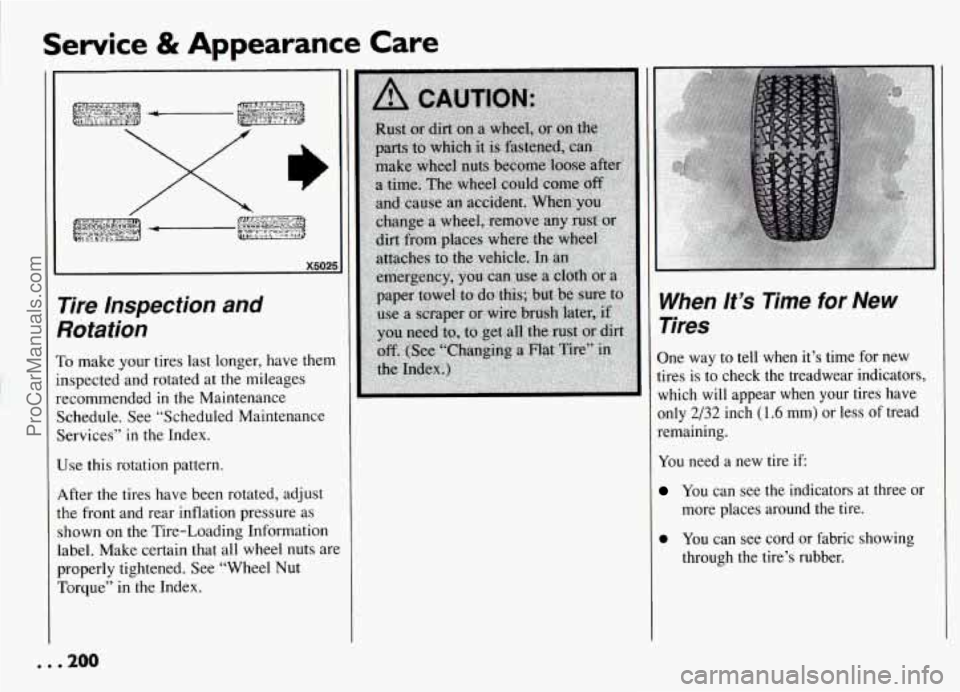
Service & Appearance Care
Tire Inspection and qotation
i’o make ,your tires last longer, have them
nspected and rotated at the mileages
ecommended
in the Maintenance
ichedule. See “Scheduled Maintenance
jervices”
in the Index.
Jse this rotation pattern.
4fter the tires have been rotated, adjust
he front and rear inflation pressure as
;hown on the Tire-Loading Information
abel. Make certain that all wheel nuts arc
xoperly tightened. See “Wheel Nut
rorque” in the Index.
When It’s Time for New
Tires
One way to tell when it’s time for new
tires is to check the treadwear indicators,
which
will appear when your tires have
only
2/32 inch (1.6 mm) or less of tread
remaining.
You need a new tire if
You can see the indicators at three or
more places around the tire.
0 You can see cord or fabric showing
through the tire’s rubber.
ProCarManuals.com
Page 210 of 274
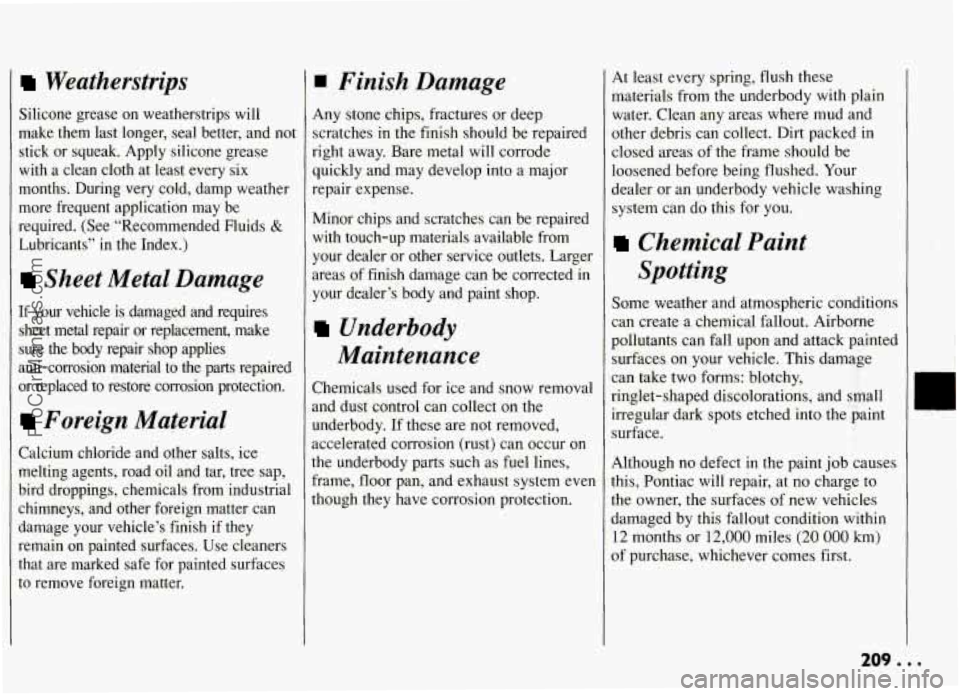
Weatherstrips
Silicone grease on weatherstrips will
make them last longer, seal better, and not
stick or squeak. Apply silicone grease
with
a clean cloth at least every six
months. During very cold, damp weather
more frequent application may be
required. (See “Recommended Fluids
&
Lubricants” in the Index.)
Sheet Metal Damage
If your vehicle is damaged and requires
sheet metal repair or replacement, make
sure the body repair shop applies
anti-corrosion material to the parts repaired
or replaced to restore corrosion protection.
Foreign Material
Calcium chloride and other salts, ice
melting agents, road oil and tar, tree sap,
bird droppings, chemicals from industrial
chimneys, and other foreign matter can
damage your vehicle’s finish
if they
remain on painted surfaces. Use cleaners
that are marked safe for painted surfaces
to remove foreign matter.
Finish Damage
Any stone chips, fractures or deep
scratches in the finish should be repaired
right away. Bare metal will corrode
quickly and may develop into a major
repair expense.
Minor chips and scratches can be repaired
with touch-up materials available from
your dealer or other service outlets. Larger
areas of finish damage can be corrected
in
your dealer’s body and paint shop.
Underbody
Maintenance
Chemicals used for ice and snow removal
and dust control can collect on the
underbody. If these are not removed,
accelerated corrosion (rust) can occur on
the underbody parts such as fuel lines,
frame, floor pan, and exhaust system even
though they have corrosion protection.
At least every spring, flush these
materials from the underbody with plain
water. Clean any areas where mud and
other debris can collect. Dirt packed in
closed areas
of the frame should be
loosened before being flushed. Your
dealer or an underbody vehicle washing
system can do this for you.
Chemical Paint
Spotting
Some weather and atmospheric conditions
can create a chemical fallout. Airborne
pollutants can fall upon and attack painted
surfaces on your vehicle. This damage
can take two forms: blotchy,
ringlet-shaped discolorations, and small irregular dark spots etched into the paint
surface.
Although no defect in the paint job causes
this, Pontiac will repair, at no charge to
the owner, the surfaces of new vehicles
damaged by this fallout condition within
12 months or 12,000 miles (20 000 km)
of purchase, whichever comes first.
C
209
ProCarManuals.com
Page 211 of 274
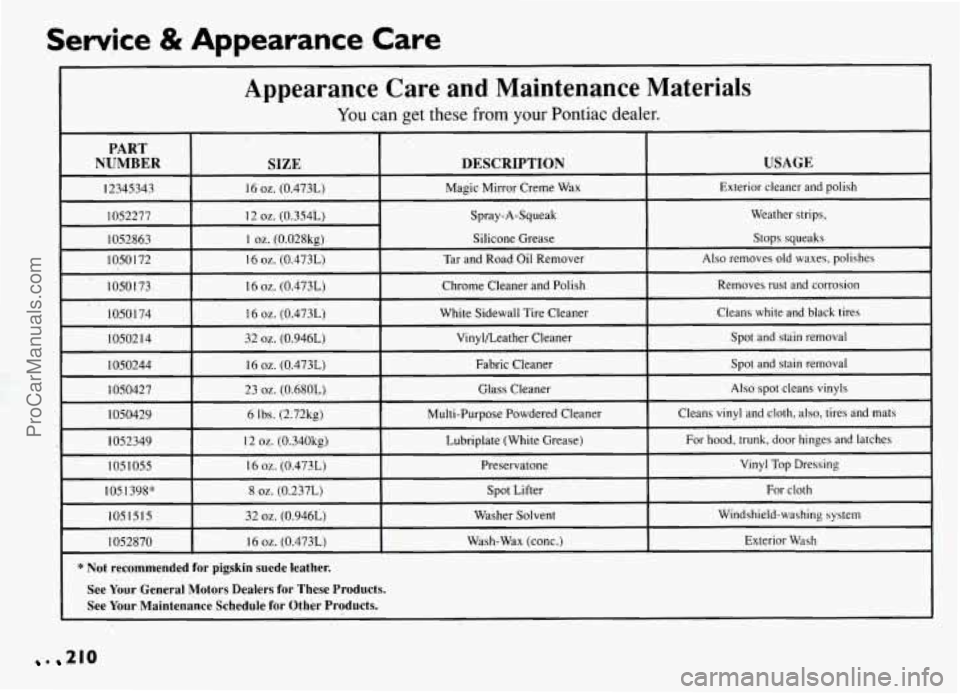
Service & Appearance Care
I
Appearance Care and Maintenance Materials
See Your General Motors Dealers for These Products.
See Your Maintenance Schedule for Other Products.
. 210
ProCarManuals.com
Page 221 of 274

Service & Appearance Care
Normal Maintenance Replacement Parts
Air Cleaner Element
2.3L Quad OHC and Quad 4 ....................
3.lLV6 ....................................
Engine Oil Filter
2.3L Quad OHC and Quad 4 ....................
3.1LV6 ....................................
PCV Valve
3.1LV6 ....................................
Spark Plugs
2.3L Quad OHC ..............................
2.3L Quad DOHC with Automatic Transaxle .......
2.3L Quad DOHC with Manual Transaxle .........
2.3L Quad High Output ........................
3.1LV6 ....................................
AC Type A- 1233C
AC Type A-1233C
AC Type PF- 1225
AC Type PF-40
or AC Type PF-47
AC Type 892C
AC Type 041-603
Gap: 0.035 inch (.889 mm)
AC Type 04 1-603
Gap: 0.035 inch (.889
mm)
AC Type 041-602
Gap: 0.035 inch (389 mm)
AC Type 04 1-602
Gap: 0.035 inch
(.889 mm)
AC Type R44 LT SM6
Gap: 0.060 inch (1.52 mm)
... 220
ProCarManuals.com
Page 224 of 274

IMPORTANT:
KEEP ENGlNE OIL
AT THE PROPER
LEVEL AND CHANGE AS
RECOMMENDED
1 This part covers the maintenance
I required for your Pontiac . Your vehick
needs these services to retain its
1 safety. dependability and emission
control performance
.
.... - .,. ....... ..
Have you purchased the
GM Protection Plan?
The Plan supplements your new vehicle warranties
.
See your Pontiac dealer for details .
Part 7
Maintenance Schedule
Introduction
A Word About Maintenance ..................................... 224
Your Vehicle and the Environment
................................ 224
How This Part
is Organized ..................................... 224
Using Your Maintenance Schedules . . ...................... 225
Selecting the Right Schedule
.................................... 225
Schedule1
................................................... 226
Schedule11
.................................................. 228
Explanation
of Scheduled Maintenance Services ................... 230
At Each Fuel Fill ............................................. 232
At Least Once a Month ......................................... 233
At Least Once a Year
.......................................... 233
AtLeastTwiceaYear
.......................................... 233
C . Periodic Maintenance Inspections ................................ 236
D . Recommended Fluids & Lubricants ................... ~ ......... 238
E . Maintenance Record .............................
~ ...... 240
A . Scheduled Maintenance Services
B . Owner
Checks & Services
223
ProCarManuals.com
Page 225 of 274
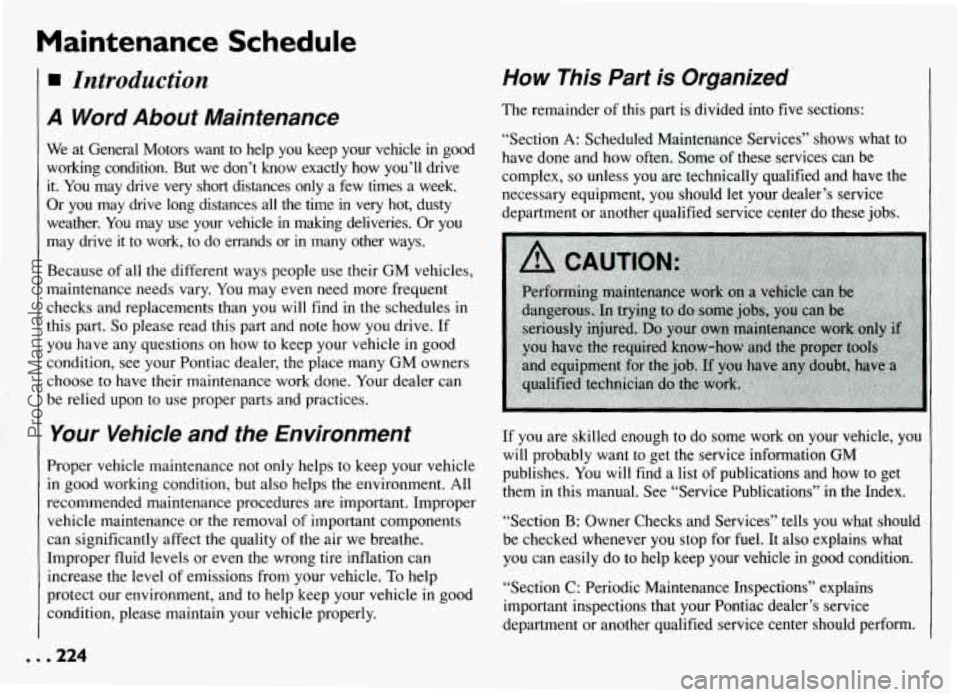
Maintenance Schedule
Introduction
A Word About Maintenance
We at General Motors want to help you keep your vehicle in good
working condition. But we don’t know exactly how you’ll d\
rive it. You may drive very short distances only a
few times a week.
Or you may drive long distances all the time in very hot, dusty
weather. You may use your vehicle
in making deliveries. Or you
may drive
it to work, to do errands or in many other ways.
Because of all the different ways people use their GM vehicles,
maintenance needs vary. You may even need more frequent
checks and replacements than you will find in the schedules
in
this part. So please read this part and note how you drive. If
you have any questions on how to keep your vehicle in good
condition, see your Pontiac dealer, the place many GM owners
choose to have their maintenance work done. Your dealer can
be relied upon to use proper parts and practices.
Your Vehicle and the Environment
Proper vehicle maintenance not only helps to keep your vehicle
in good working condition, but also helps the environment. All
recommended maintenance procedures are important. Improper
vehicle maintenance or the removal of important components
can significantly affect the quality of the air we breathe.
Improper fluid levels or even the wrong tire inflation can
increase the level of emissions from your vehicle.
To help
protect our environment, and to help keep your vehicle in good
condition, please maintain your vehicle properly.
How This Part is Organized’
The remainder of this part is divided into five sections:
“Section A: Scheduled Maintenance Services” shows what to
have done and how often. Some--of these services can be
complex,
so unless you are technically qualified and have the
necessary equipment, you should let your dealer’s service
department or another qualified service center do these jobs.
If you are skilled enough to do some work on your vehicle, you
will probably want to get the service information
GM
publishes. You will find a list of publications and how to get
them in this manual. See “Service Publications” in the In\
dex.
“Section B: Owner Checks and Services” tells you what should
be checked whenever you stop for fuel. It also explains what
you can easily do to help keep your vehicle in good condition.
“Section C: Periodic Maintenance Inspections” explains
important inspections that your Pontiac dealer’s service
department or another qualified service center should perform.
ProCarManuals.com